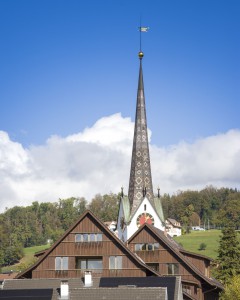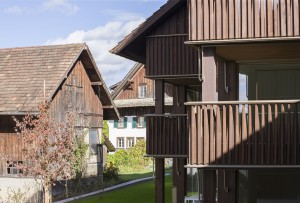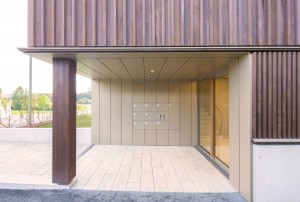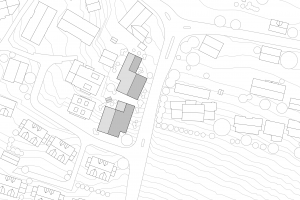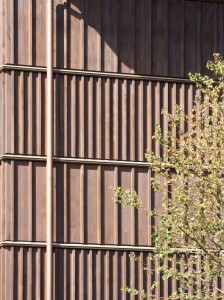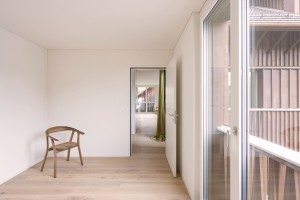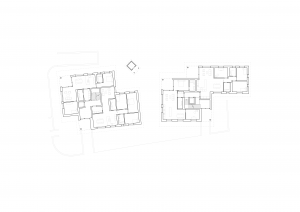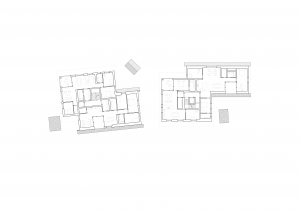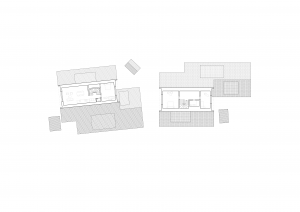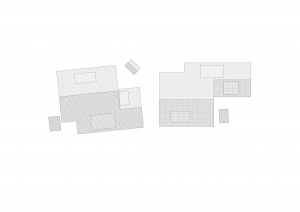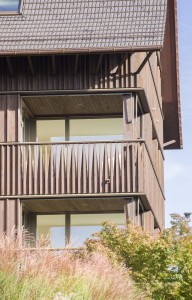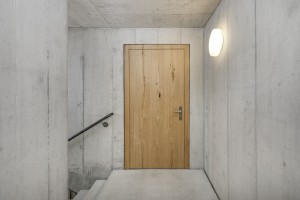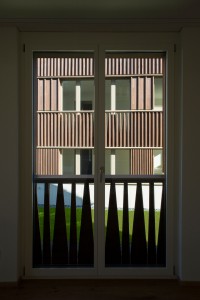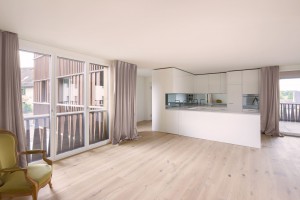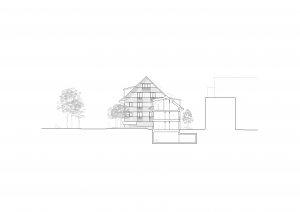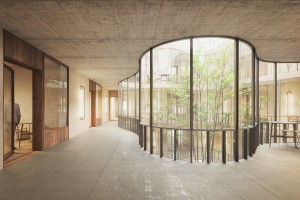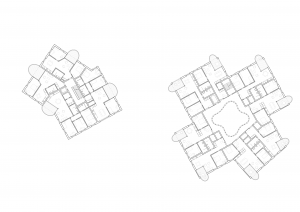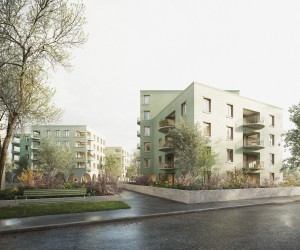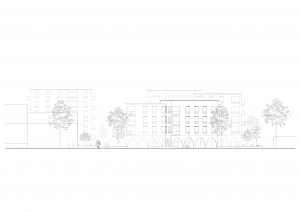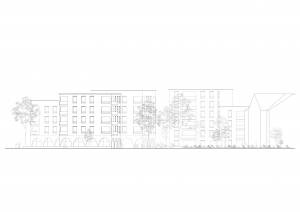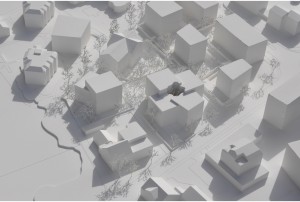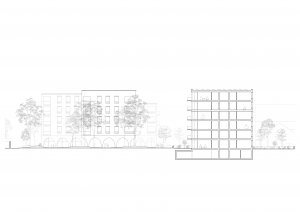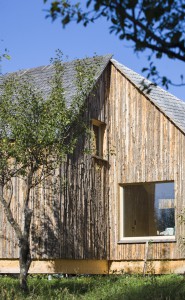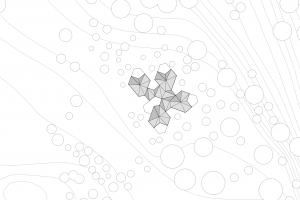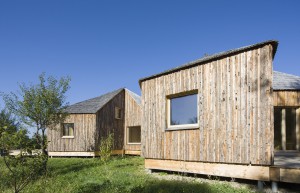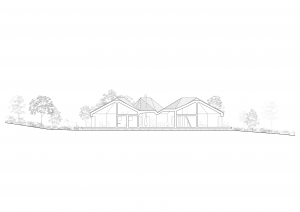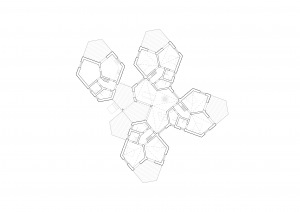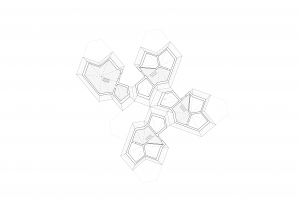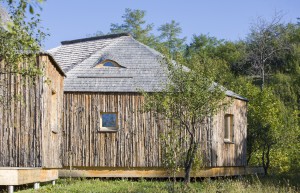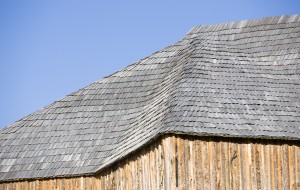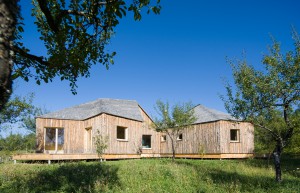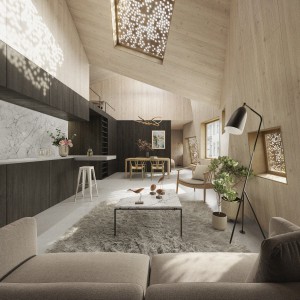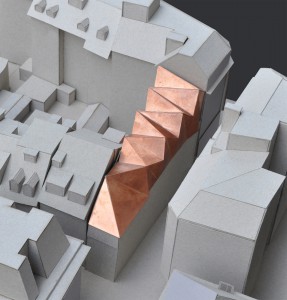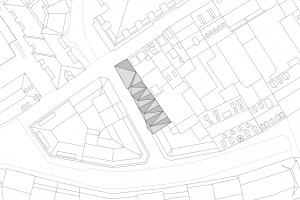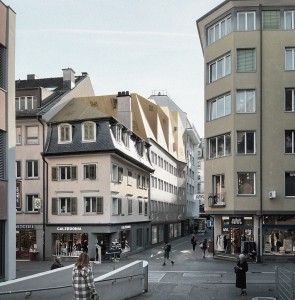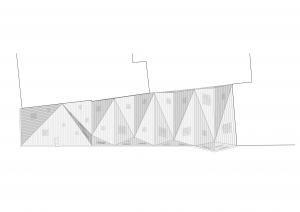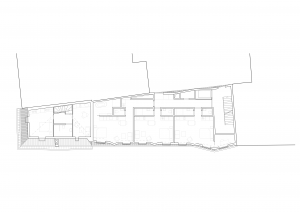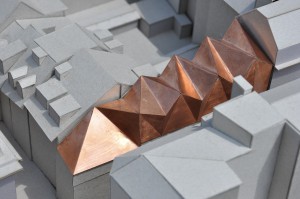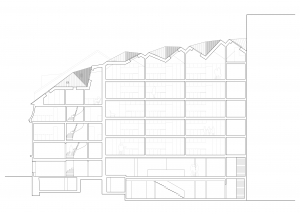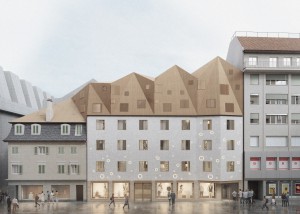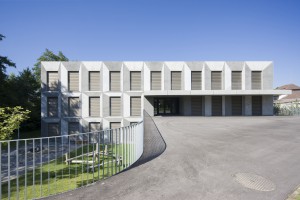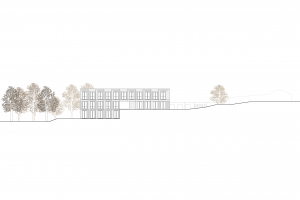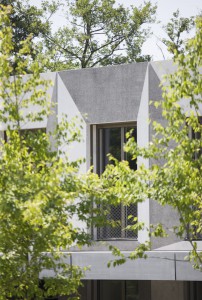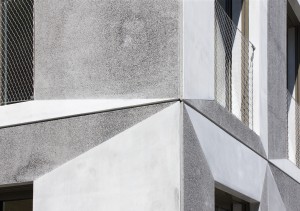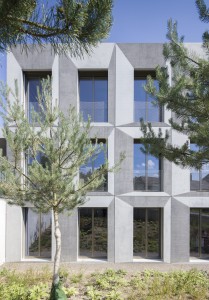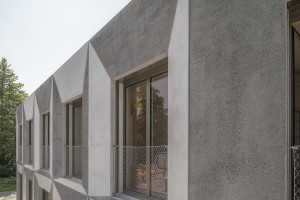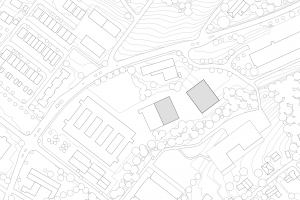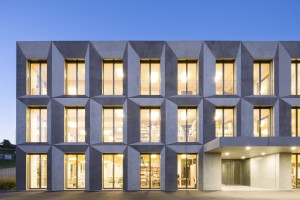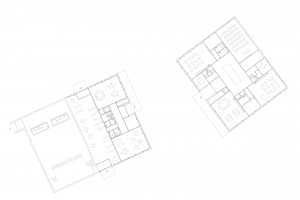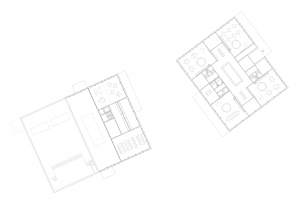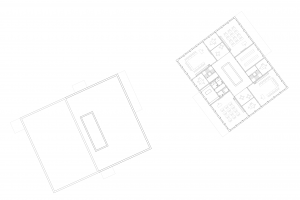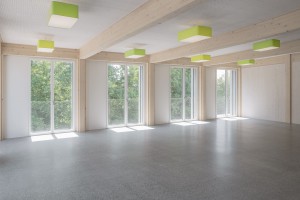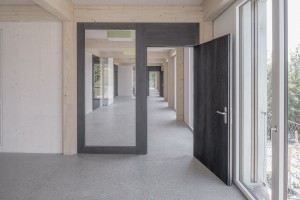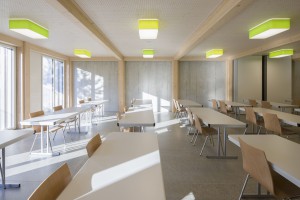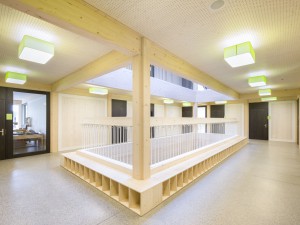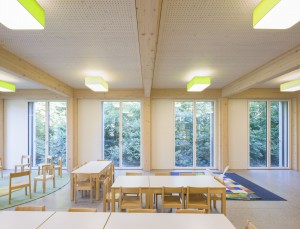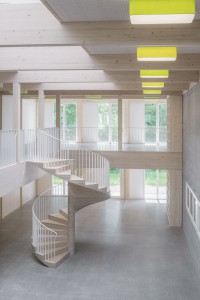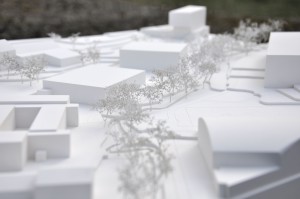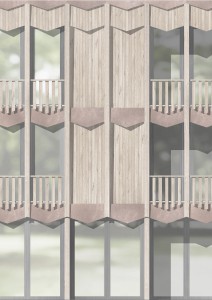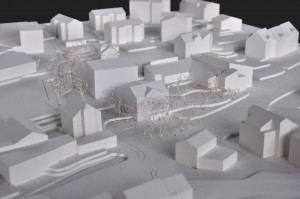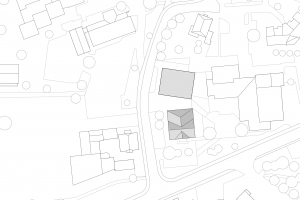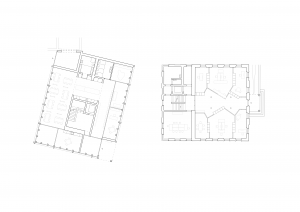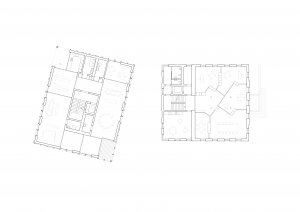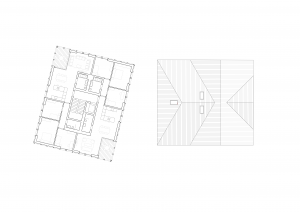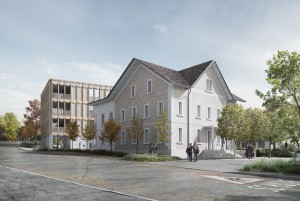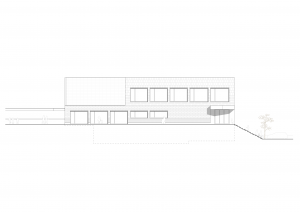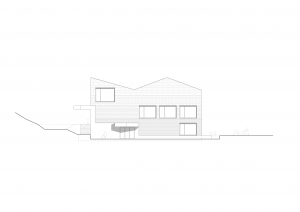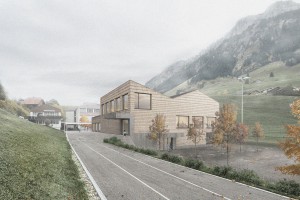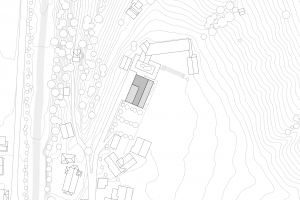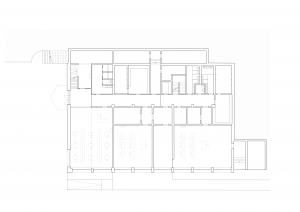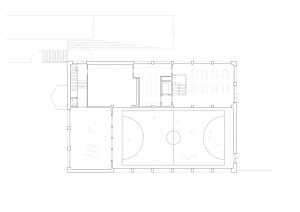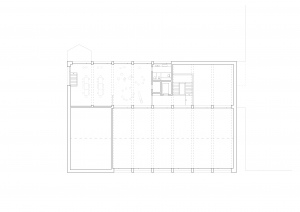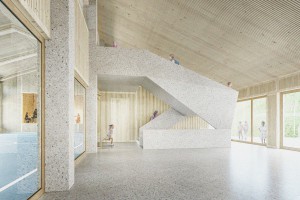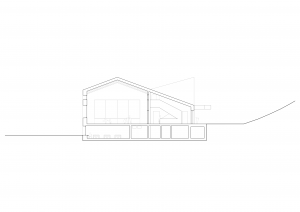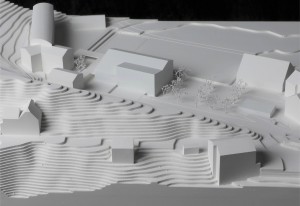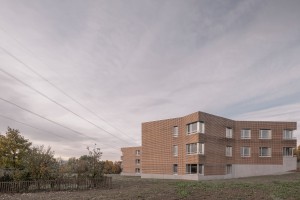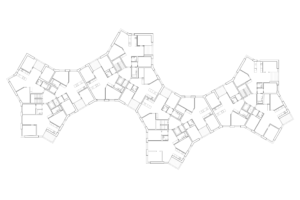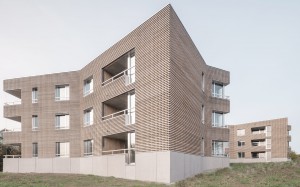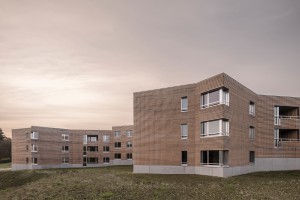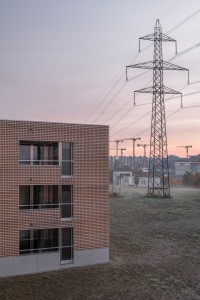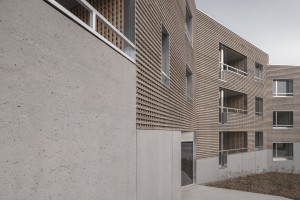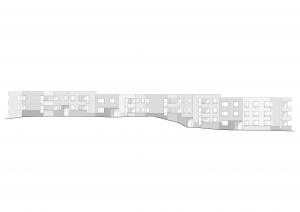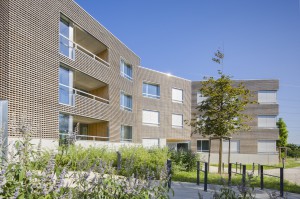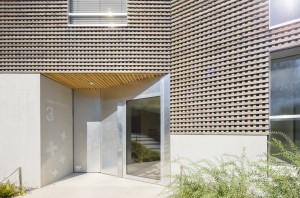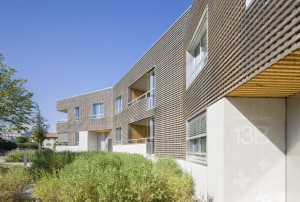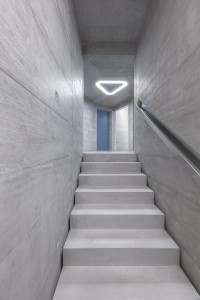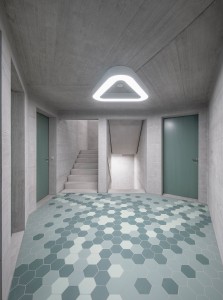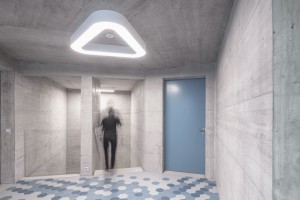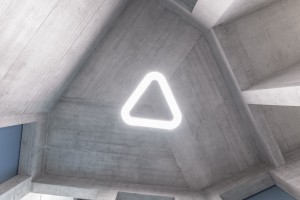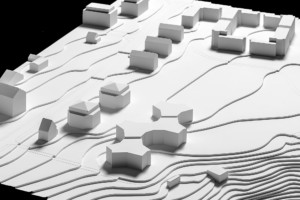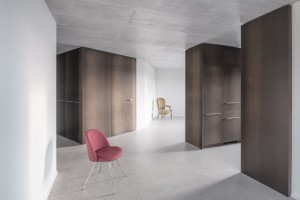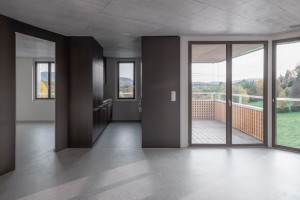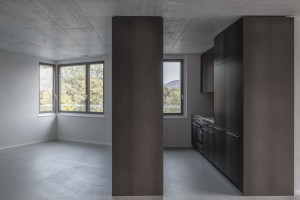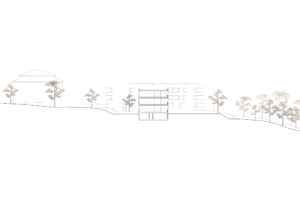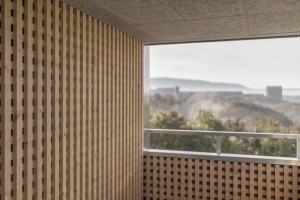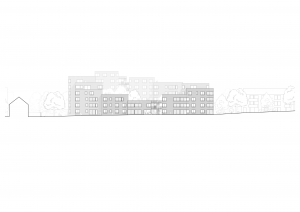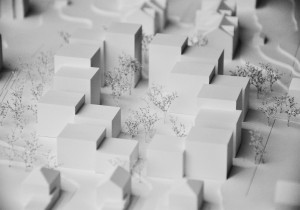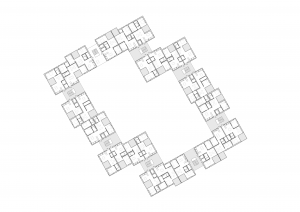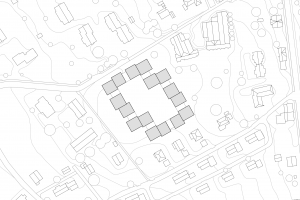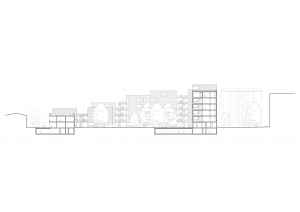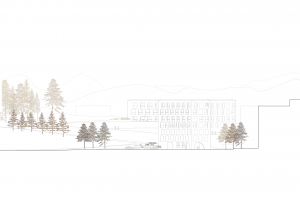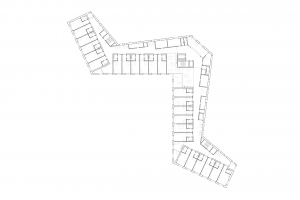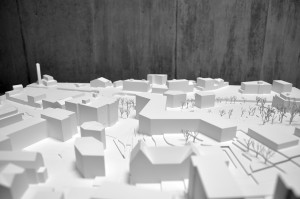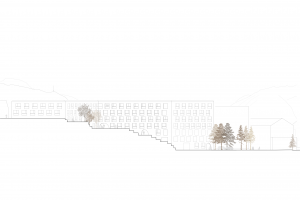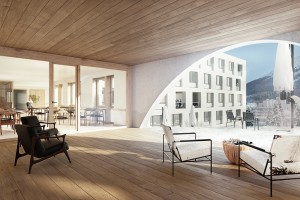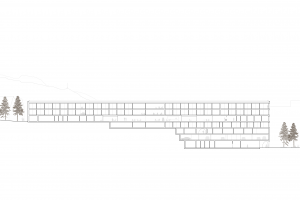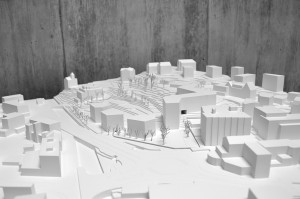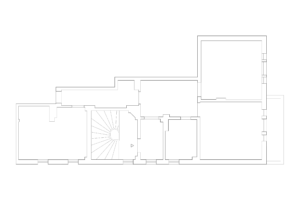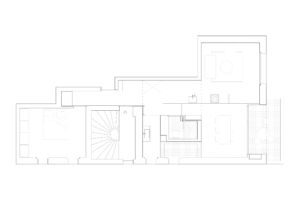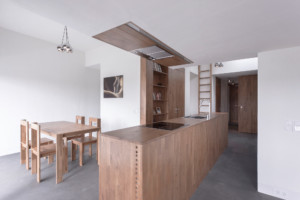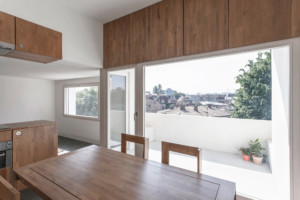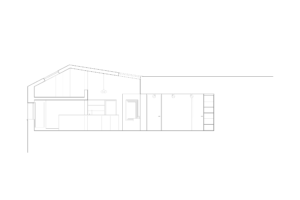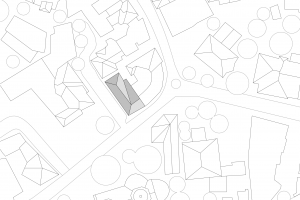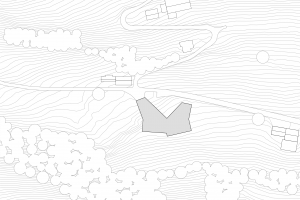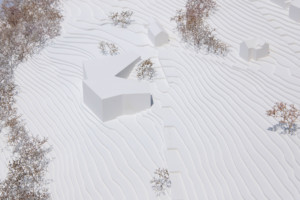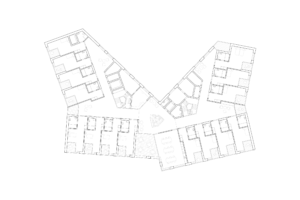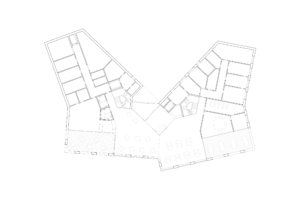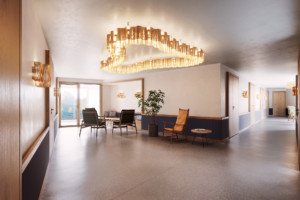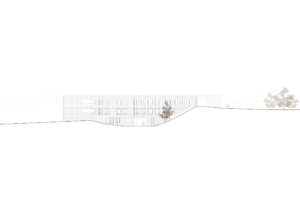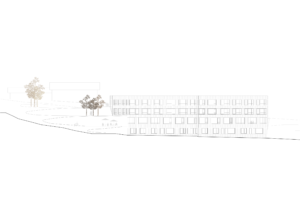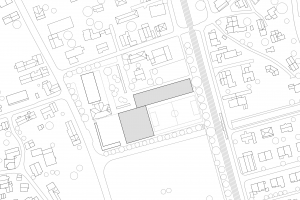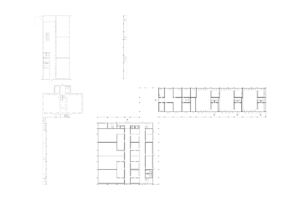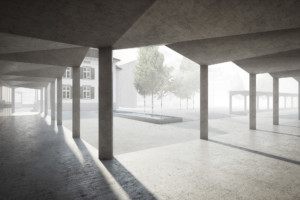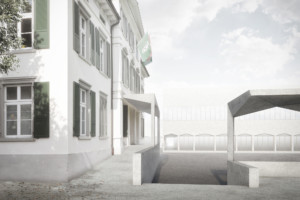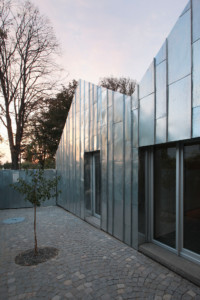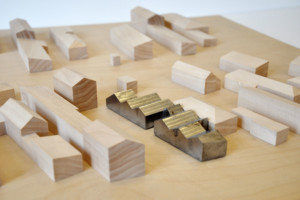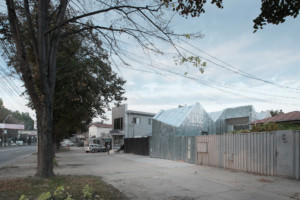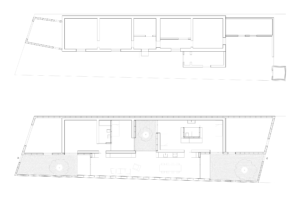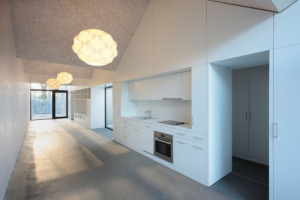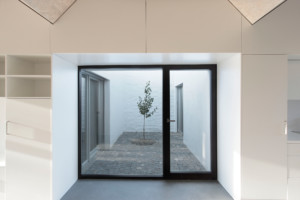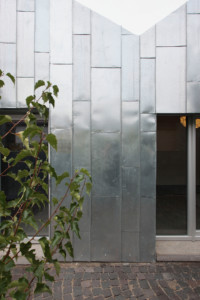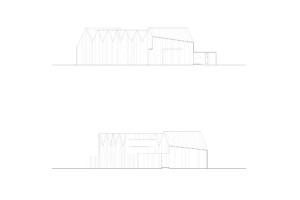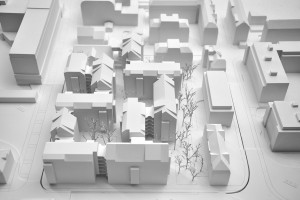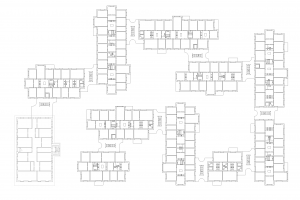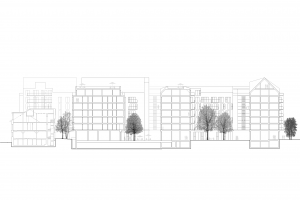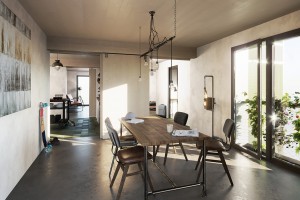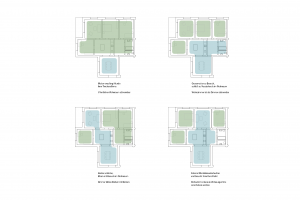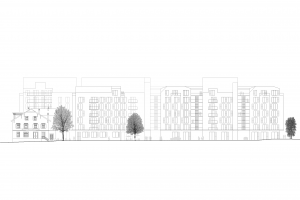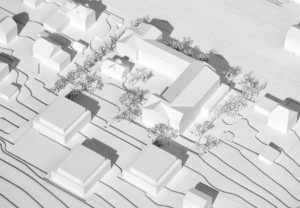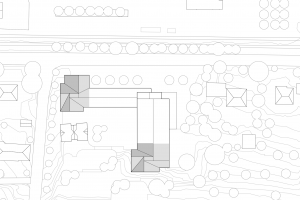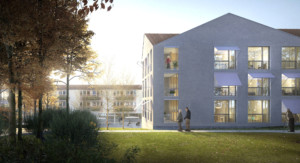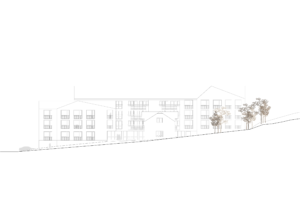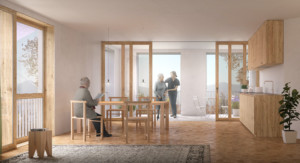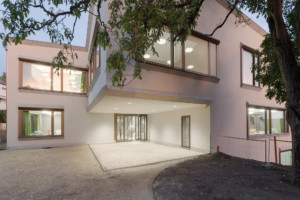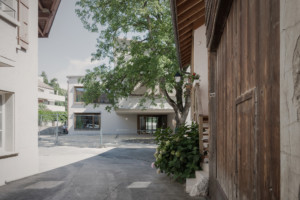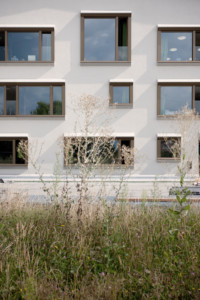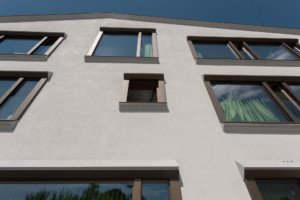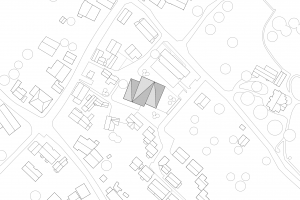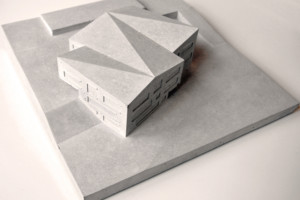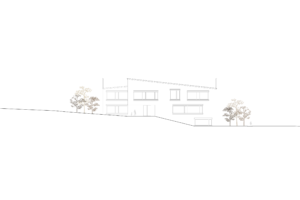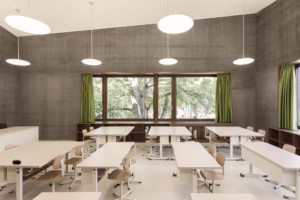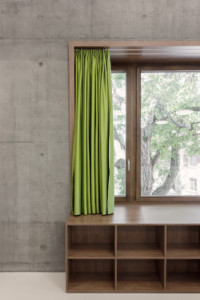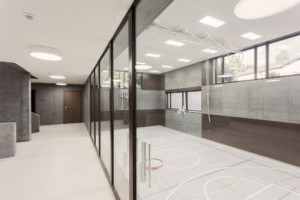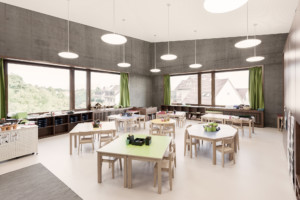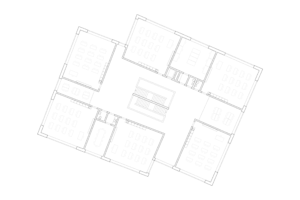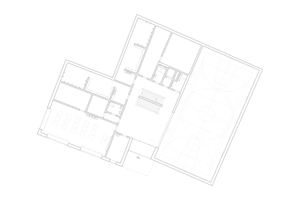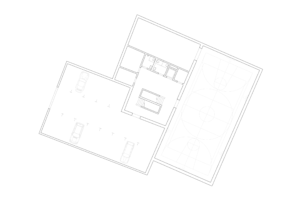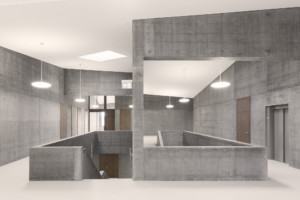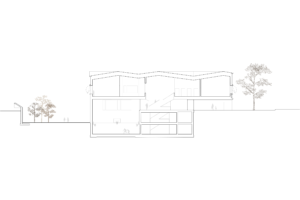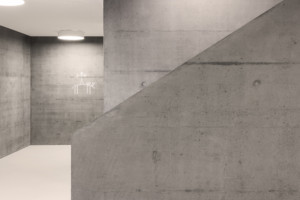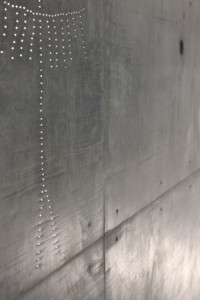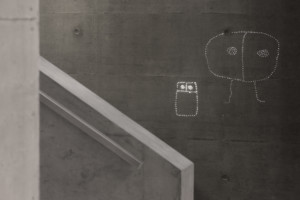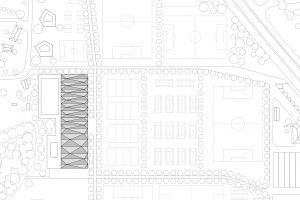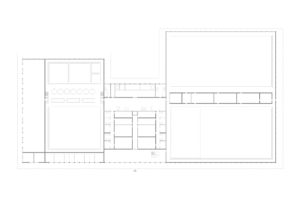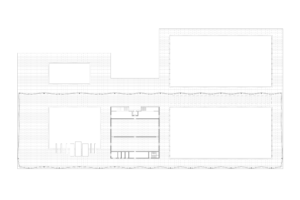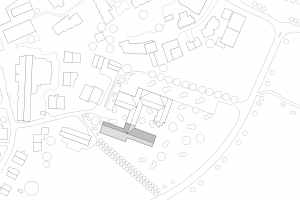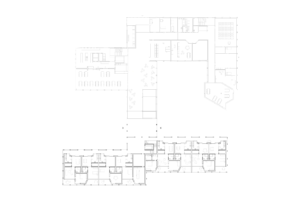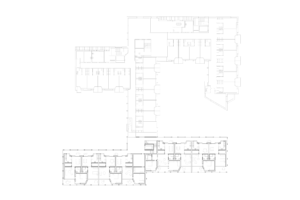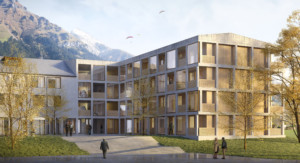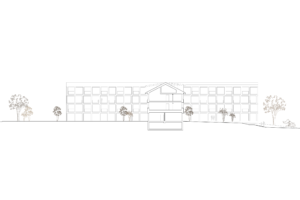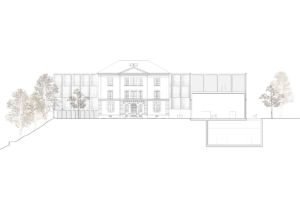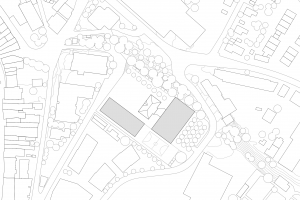ATELIER
Founded in 2012 by Andreas Heierle, ahaa quickly made a mark by winning an open competition for a school in Lausanne-Crissier the same year. Shortly afterwards the studio garnered awards and publications for two modest, conceptually prototypical residential projects in Romania.
In Switzerland, ahaa thrives on diverse competition-acquired tasks, tackling architecture across various usage areas and scales. The studio’s ethos revolves around creating distinctive places with a strong identity, always rooted in what already exists. Each project aims to identify the particular quality of a place and develop it further. Context and user-centric design are paramount in the approach.
ahaa embraces different cultural, technical, and programmatic conditions, finding creative dynamism in each while restrictions and seemingly contradictory starting points stimulate the design process. The multicultural team, drawing from a variety of life and professional experiences, shapes ahaa’s daily work. The studio strives to avoid local clichés and transient fashions. Intercultural and interdisciplinary exchange is integral, fostering diverse impulses and a wide range of solution approaches.
TEAM (*current)
Carligianu Andi, Jasper Andresen, Ivan Ashkinadze*, Melanie Bareither*, Mengxing Cao, Daniel Carvalho, Davide Gennari*, Miriam Giegerich*, Andreas Heierle*, Elena Ifrim, Stepan Mares*, Naznin Parvin, Arne Piel*, Barbara Romanska, Michael Roth*, Jacopo Ruggeri*, Sara Sali, Zeljko Savic, Jean-Michaël Taillebois, Joan Albert Tolrà Campanyà*, Cristina Trofin, Harri Verhofnik*
Drei Linden
Mettmenstetten, Switzerland
1st prize, invited competition 2020
Construction: 2022 – 2023
Client: Meili Unternehmungen
Images: Andrei Margulescu / Jeronimo Vilaplana
Magdalena, Jean-Luc und Tim
Lyss, Switzerland
At first glance, the large buildings in Grentschel appear to be randomly scattered across the valley floor. However, the unassuming Grentschel stream actually plays an organising role. Each building volume is oriented to the course of the stream and positioned parallel to it. The project adopts this logic, resulting in a relaxed ensemble with fluid outdoor spaces.
The new rooms are divided between two buildings. In the centre of the campus, a two-storey construction houses the spaces collectively used by all pupils – assembly hall, library and day school. To the east, the new school building houses classrooms within three storeys. The designated didactic use of the rooms is just a snapshot and tends to change quickly, therefore the project proposes a structure which enables the function of the individual rooms to be interchangeable. The spatial qualities are distributed democratically. The classrooms in the remedial school, primary school, and kindergarten all have the same proportions and dimensions, and benefit from floor-to-ceiling windows on two sides that incorporate the green outdoors.
The very rational façade is simple, repetitive and rectilinear, but with its alternating smooth and sandblasted surfaces, is given an almost playful appearance. This tromp l’oeil effect suggests a depth which does not really exist and gives the buildings a light, classically elegant appearance which contrasts with the wild romantic landscape of the Grentschel stream.
1st prize, selective competition 2017
Construction: 2020 – 2021
Client: Gemeinde Lyss
Landscape: weber + brönnimann
Timber Engineer: Makiol Wiederkehr
Artwork: Zimoun
Images: Stefan Zuerrer / Andrei Margulescu
Ivy
Vernier, Switzerland
The new building with 32 apartments is situated on the outskirts of Geneva on a gentle south-facing slope. The building is inhabited by custom officers with an irregular daily routine and the noise pollution due to its proximity to the motorway and airport entails high user-specific soundproofing requirements. The new building’s special floor plan emerges in the wake of this issue, based on an individual apartment whose living space faces two or three sides. Thus giving the residents the advantage that they always have a choice of which direction they want to face.
The polygonal building volume avoids having to turn the back on the existing buildings and integrates them into the new logic of the communal outdoor spaces. The floor plan’s efficient organisation of space, which always organises three apartments around a central circulation area, allows to compensate for the relatively large façade and creates economical apartments. The organic floor plan that looks wild at first glance is structured extremely rationally and only uses two angles. Each room in the building has at least three easily furnishable right angles while any residual surfaces in the layout are reduced to an absolute minimum.
1st prize, open competition 2014
Construction: 2018 – 2020
Client: Federal Office for Construction BBL
Landscape: weber + brönnimann
Images: Stefan Zuerrer / Andrei Margulescu
Salamander
St. Moritz, Switzerland
The nursing home functions as an extension of the town centre, by incorporating its compactness and nestling into it. The volume of the new building continues the row of larger houses to the east while with a continuous roof height, fits with the small residential buildings to the west. Or, looking at it another way, the building emerges out of the topography as a horizontal volume that fuses as a vertical volume with the body of the town.
The volume’s polygonal layout reacts in a sensitive way to its neighbours and avoids a barricade effect while creating ideal conditions for the arrangement of the rooms.
With steps across several terraced areas, it transforms its face and scale from ‘urban’ to ‘rural’ while simultaneously interlinking the various levels of the town. While the building is symmetrical in its layout and precisely oriented to the south, volumetrically this symmetry is completely blurred by the steep inclination of the terrain.
The polygonal layout in conjunction with the steep terrain determines the appearance of the building. The beholder always sees various parts of the façade, each with a different height, each at a different distance, making it difficult to discern whether it is one and the same building.
The breaks in the structure fragment the imposing volume and the graduated perception allows the building to appear smaller than it actually is. In keeping with the style of traditional Engadine buildings, repetitive, angular window openings are contrasted with freely shaped arches that mark the entrances. This combination of the rational and the emotional gives the project, despite its idiosyncratic form, a natural intimacy.
2nd prize, selective competition 2018
Client: Gemeinde St. Moritz
Landscape: weber+brönnimann
Structural engineer: weber+brönnimann
Images: Motiv
Under the Attic
Bucharest, Romania
The screed under the pitched roof is left unused in most Romanian residential buildings as fire safety regulations do not permit for its use. A lot of potential space is left unexploited. This is also the case in this interwar period housing block where the young owner outgrew the apartment on the top floor with its cellular structure.
To create a feeling of spaciousness in the tight space, the project establishes various visual relationships in particular by breaking up the sanitary functions. The living and dining area surround a previously barely usable terrace extended inwards; the free-standing kitchen furniture divides it without cutting the visual reference. An astonishing abundance of space is created by introducing the third dimension. A previously dark, unattractive corner becomes the spatial heart thanks to zenithal lighting. The project evades the usual clichés associated with attic apartments as the roof space is only integrated in a fragmentary way to create vertical accents in places.
Built-in furniture units turning the corners accentuate the flowing space. A minimalist selection of materials avoids them competing with the spatial diversity. Like the resident, the apartment has something eccentrically cosmopolitan and modestly down-to-earth at the same time.
Direct commission 2011
Construction: 2012 – 2013
1st prize, Anuala 2014, Bucharest, Interior
Nomination, EU Mies Award 2015, Barcelona
Images: Andrei Margulescu
Argus
Amden, Switzerland
When you branch off to the nursing home coming from Amden and then head towards Äschen, you quickly leave the village behind you. Long before the last houses mark the edge of the village, you feel like you’ve escaped civilisation. The mountain and panorama determine your perception. The new home clearly stands out from the functional buildings in the area due to its scale and use. It therefore isn’t looking to follow the style of the building context but is guided by the landscape.
The building sits on the slope like a jagged rock. The building’s shape originates from the topography of the terrain it is growing out of and the panorama it opens up to. Thanks to its fragmentation, the building structure looks smaller than it actually is.
The heart of the home are the two nursing wards, which the majority of the residents cannot leave without assistance and above all where they spend their last remaining days. Consequently, the two wards are situated on the privileged top floors where the view over the forest of the mountain panorama is guaranteed from all sides and there is also a visual reference to the slope. Two established room types with Z and T floor plan guarantee every resident a direct view of the panorama from their bed despite the building wings facing different directions.
The communal areas manage without any corridors and allow for a variety of views in all directions on all sides.
2nd prize, selective competition 2017
Client: Gemeinde Amden
Images: Motiv
Palaestra
Buchs, Switzerland
The school complex with its scattered outside spaces is to be reorganised. A double sports hall, kindergartens, daycare facility for children, general and specialist classrooms are to be distributed partly over the existing and partly over new buildings. The complex is going to be surrounded on all sides by residential buildings in a few years, which is why it should be open and accessible all round as a free space. The outside areas are to be distributed around the school building as equal spaces avoiding a front and back. The listed old school building is given a fitting forecourt thanks to the positioning of the new double sports hall.
The wide flat land’s use for sport and as a school led to the ancient palaestra reference, which was organised around a large court surrounded by pillars. As there is no need to protect the introverted court in the village setting of Buchs, the portico in the centre is being separated and reassembled corner to corner. Thus connecting the various scattered outside areas together and bringing them to life.
2nd prize, selective competition 2014
Client: Gemeinde Buchs
Images: Onirism / Studio 12
House with Three Courtyards
Galati, Romania
The existing “wagon house” on a classic long and narrow plot of land typical for Romania had developed over generations through the traditional connecting of rooms one after the other. Like many others of its kinds, it no longer met the current usage requirements in any way and was to be demolished or abandoned.
The two basic problems of this type, lighting and access to every room, are solved by a simple but radical architectural gesture. The structural fabric of the building is largely preserved and allows the residents to continue living in a home steeped in history.
By incorporating a long living room on the side and at the same time transforming one indoor room into a central outdoor space, every room can be accessed directly as well as lit naturally through the intimate courtyard in front of each one. Small gable roofs replace the unsound roof and trace the outline of the house’s original cells. As a result, the new living space grows out of the existing building and is given its own unique character at the same time. The building’s shape and homogeneous metal skin are reminiscent of warehouse or commercial buildings and an ironic play on the many parasitic uses that the city’s living quarters have to battle with.
Direct commission 2010
Construction: 2012 – 2013
1st prize, Anuala 2013, Bucharest, Residential
Images: Andrei Margulescu
Zweiter Frühling
Lucerne, Switzerland
The aim for Industriestrasse is to become a lively and vibrant district. A colourful place, full of life, which is distinguished by a strong sense of community among its residents. The project attempts to incorporate and provide a new interpretation of random, evolved, complex and mutable qualities which already exist on the site today.
The houses almost rub together like they do in old towns, which leads to the emergence of spaces between them which are full of contrasts. The desired diversity should emerge from this basic urban framework, from the strong character of the houses built by different developers and architects, as well as the strong differentiation of outside spaces.
The new buildings are, on the one hand, individual houses at the scale of the neighbouring buildings, on the other, they all belong to and form a single larger unit. Perception oscillates between both interpretations and does not allow distinct categorisation. The dimension, setting and shape of the new buildings aim to weave together the old and the new. The various roof shapes and the footprints derive from the surrounding architecture. The project views the district as an ensemble and aims to integrate the neighbouring buildings into the overall composition. A high degree of permeability should interlink the area with the city and prevent the emergence of an inside-and-outside separation.
The aim of the project is to present an alternative concept to conventional housing and its dictum of “as much light and as much of a view as possible for the individual apartment.” This dictum defines a morphology and inevitably leads to strict limitations. Just as a more intensive social exchange is sought by residents, the architectural project also seeks more proximity than is usual in our latitudes.
The project is in search of a human scale. Although the buildings are large, they are highly articulated by offsets, bays and openings. Walking through the neighbourhood again and again new spaces open up and silhouettes vary despite the density of the development.
5th prize, invited competition 2018
Client: Kooperation Industriestrasse
Landscape: Studio Vulkan
Structural engineer: Lauber Ingenieure
Images: Motiv
Amaryllis
Büren an der Aare, Switzerland
The retirement home is situated at the edge of the village in a small-scale residential district and stands out like a sore thumb in its surroundings due to its shape and size. The fact that an extension will make the size of the building even bigger is being counteracted by the delicate features on the ends of the two new buildings. They emerge from the existing building on the one hand and try to pick up on the surrounding district in their size on the other hand with their projections and recesses and gable roofs.
Based on the existing corridor with linearly arranged rooms, the communal area on the nursing floors extends towards the end of the building and fans out like a windmill searching for light and a view. At the same time, three well exposed communal rooms facing the different corners of the building are created per residential group. Each residential group therefore has two spatial focuses: firstly the quiet, intimate communal area without any through traffic and secondly the bustling zone with main circulation and wards in the middle of the building.
The project is an attempt to turn a generic, quite anonymous building into a specific interior landscape whose qualities democratically benefit all users.
4th prize, selective competition 2017
Client: Altersheim Büren an der Aare
Images: Onirism
Flintstone
Crissier, Switzerland
The new school building with 6 primary classes, 2 kindergartens, a gym and auditorium is situated in the middle of the village, right next to the historic village centre. The school children come from all directions and the view on all sides is exciting. Consequently, the building does not have a specific orientation and can be entered from two sides on two different levels. The large construction volume is integrated into the small-scale setting by two recesses and several bends in the roof, forcing itself into the tight building perimeter.
The school is organised around a double central staircase which is the unifying element that links all four floors to each other and at the same time allows for escape over two separate fire compartments in the event of a fire. Thanks to the central layout of the two staircases, corridors are avoided and the circulation area is minimal yet can be used on all floors as a spacious foyer. Although large parts of the building are sunken, all the classrooms are lit from two sides, the gym even from three.
The seemingly randomly arranged façade openings do not follow an externally imposed design principle but are a direct reproduction of the organisation inside. The lintel and parapet details show affiliation with local vernacular elements but are formally alienated and functionally reinterpreted to accommodate technical elements such as sunscreens.
1st prize, open competition 2012
Construction: 2014 – 2016
Client: Commune de Crissier
Collaboration: Daniel Wili
Civil engineer: Muttoni Fernández
Artwork: Atelier Daniel Schlaepfer
Images: Andrei Margulescu
Float
Tenero, Switzerland
The sport campus’ distinctive horizontal style and expanse appears to be mainly responsible for the genius loci: the virtually scaleless plane is to become the project’s central idea as the main ingredient for the place’s identity. The simplicity and pragmatism of the rectangular development pattern are seen as quality: this design is to be reinforced and expanded.
The building is organised on two floors. The introverted ground floor accommodates all the technical functions as well as the entrance and cloakrooms. The extroverted top floor is exempt from being used for anything else and is exclusively for sport. The large hall is given a rhythm and covered by a space-creating concertinaed roof without any supports. The indoor swimming pool’s long, light volume floats, as it were, over the campus on the projecting solid concrete base. Besides the sheer length of the building, the horizontal thrust is also accentuated by the recessed base. Despite its considerable size, the volume looks like a recumbent pavilion due to the ratio between the building length and height and the back folded roof.
While the floor plan follows a strict rectangular layout, the building breaks away from this rigour in its profile. The sculptural roof throws itself up over the diving tower and traces the outline of the surrounding Ticino mountains with its silhouette.
5th prize, open competition 2017
Client: Federal Office for Construction BBL
Landscape: Christoph Wey
Civil engineer: BlessHess
Energy and building technology: JOP
Images: Eve
Semper viridis
Engelberg, Switzerland
30 new retirement apartments are to be built on land on the outskirts of the village and the existing retirement home is to be modernised with roughly 50 rooms and adapted to current standards. The project is based on the size and structure of the existing nursing home, which it is developing further. This results in a harmonious ensemble that is strongly interwoven with the village structure, compared to the situation today. It also gives rise to a relationship with the nearby monastery both morphologically and typologically.
For a high level of flexibility, the old and new building are connected on all floors so that the retirement apartments can be converted into nursing rooms if needs change in future. The apartment floor plan is also based on the principle of adaptability: the bedrooms can always be allocated to one or another apartment. Access to the apartment over a balcony that is open in the summer expands on the old building’s type of circulation and establishes a close relationship with the newly created courtyards sheltered from the wind as a semi-public meeting place.
3rd prize, selective competition 2015
Landscape: weber + brönnimann
Client: Gemeinde Engelberg
Images: Onirism
Hic et Nunc
Liestal, Switzerland
The building context at Gestadeck is very heterogeneous. Buildings with diverse uses, sizes and orientations do not indicate a clear urban pattern. The project wants to coherently fit into the district by solving various specific tasks on a small scale.
With this in mind, the space allocation is being divided over two buildings to get closer to the scale of the existing school building. Both cuboids are consistently aligned with an orthogonal pattern thus arranging the area based on the original Neoclassical building. The buildings are positioned so that well proportioned, clearly defined outside areas facing different directions are created for various uses.
The new school building’s floor plan is designed simply, repetitively and modularly and guarantees a high level of flexibility in planning and use. The double-loaded standard floor with central circulation allows for each floor to be divided into two autonomous learning groups. The two sports halls are offset from each other with the underground hall being lit by skylights and the aboveground hall opening up onto the court across the whole length. An all-weather pitch on the roof completes the offer of diverse outdoor-spaces.
4th prize, selective competition 2017
Client: City of Liestal
Images: Studio 12


